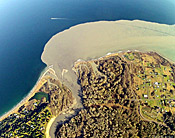Scientists tracking the aftermath of the largest dam removal in U.S. history say the dismantling of a dam in northwestern Washington state has unleashed about 34 million cubic yards of sediment and debristhat built up
for more than a century. While about one-third of the 210-foot Glines Canyon Dam on the Elwha River still stands, vast amounts of sediment are already flowing downstream, allowing University of Washington (UW) scientists a rare opportunity to track the discharges and study their ecological impacts. Scientists say it is unclear where much of the sediment will end up — or what the environmental consequences will be. In an ongoing study, they will use sophisticated technology to track particles in the water and monitor their accumulation on the ocean floor. Scientists say the sediment — enough to fill 3 million truckloads — could create murkier water conditions, threatening the reproduction of salmon and blocking light for marine life.

Tom Roorda
A plume of sediment at the mouth of the Elwha River.